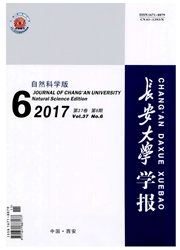

 中文摘要:
中文摘要:
以正确识别简支梁桥实际刚度分布为目标,建立了集中荷载作用下单梁区段刚度与挠度间的关系方程组,结合位移互等定理推导了全梁多区段的实际刚度分布表达式;建立了标准双轴车与三轴车移动过桥时其跨中挠度曲线向集中荷载作用影响线转换的关系方程,从而凭借双轴车与三轴车低速行驶过桥时采集的跨中挠度时程曲线推导简支梁桥纵桥向的实际刚度分布状况,分析全桥实际病害分布范围及损伤程度;编制了配套计算软件,对比验证了桥梁刚度分布识别算例与相关研究资料。研究结果表明:由于损伤原因的多样性及复杂性,简支梁各区段损伤程度各不相同,梁体实际刚度分布沿纵桥向呈非线性变化,不宜采用设计规范提出的全梁整体刚度作为在役简支梁桥运营过程中局部损伤和病害的评判计算标准;给出算法得到的简支梁桥纵桥向实际刚度分布与实际工程受损情况吻合良好,可应用该方法快速、真实、可靠地反映在役桥梁整体损伤状况,锁定简支梁桥损伤范围并正确估算其损伤程度。
 英文摘要:
英文摘要:
This paper focused on studying the real stiffness distribution in a simply supported beam.The relation equations between stiffness and deflection in a bridge segment has been established.based on the material mechanics,numerical modeling,and reciprocal displacement theorem.The relation equation of the conversion of the deflection curve at mid span to the concentrated load effect curve resulted from three axle vehicle passing over the bridge has been developed so that,by measuring the deflection curve caused by low speed of the vehicle passing over the bridge,the longitudinal real stiffness distribution of the bridge could then be obtained and the assessment of the bridge damage and its distribution range could be carried out.Compatible software was developed in accordance with the proposed stiffness calculation method.It's found that the software worked well in predicting the stiffness distribution and the test results indicated that theproposed prediction method was applicable.The test results showed that the stiffness distribution in longitudinal direction varied significantly,which is due to the different degrees of damage.The analysis showed that it is not suitable to use the overall stiffness as the criteria to evaluate the damage of the whole beam.The measured data matched pretty well with the calculated stiffness distribution and the proposed method presented its applicability in engineering practice,such as predicting the stiffness decay,detecting the damage area,and estimating the degree of damage.
 同期刊论文项目
同期刊论文项目
 同项目期刊论文
同项目期刊论文
 期刊信息
期刊信息
